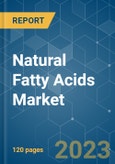COVID-19 impacted the overall natural fatty acid market due to the halt in production. However, the upsurge in cosmetics and personal care products has propelled the demand for fatty acids post-pandemic.
Key Highlights
- The major factors driving the growth of the market studied are the increasing demand for glycerin to manufacture propylene glycol and epichlorohydrin, government regulations promoting the use of eco-friendly products, the broader use of C18 in oilfield and drilling applications, and the increasing demand from the cosmetics and personal care market.
- On the flip side, the fluctuating supply and prices of feedstock materials serve as the major stumbling blocks in the growth of the market studied.
- During the forecast period, the market that was looked at is likely to have opportunities due to the demand for bio-based raw materials.
- Asia-Pacific dominated the market across the world, where the demand is primarily driven by the growing demand for and production of cosmetics, personal care products, detergents, and soaps.
Natural Fatty Acids Market Trends
Household, Cosmetics, and Personal Care Segment to Dominate the Market Demand
The antibacterial, antifungal, and antiviral properties of natural fatty acids make them widely popular for use in the household, cosmetics, and personal care markets.- Besides, fatty acid provides an opacifying effect and consistency and increases the thickness of the product. As a result of these properties, natural fatty acids are widely used in cosmetics and personal care products.
- The personal care and cosmetic industry accounted for around USD 317 billion in 2021, with Asia-Pacific and Europe leading the market, which is expected to be driven by high demand for such products in these markets. Also, by 2027, the personal care industry is expected to be worth about USD 354,80 billion.
- According to the Industry Association for Personal Care and Detergents e. V. (IKW), revenues from laundry detergents and cleaning products in Germany accounted for EUR 5.09 billion (USD 6.02 billion) in 2021, compared to EUR 5.24 billion (USD 5.98 billion) in the previous year.
- Furthermore, in United States, the average annual expenditures for soaps and detergents amounted to roughly USD 80.5 per consumer unit in 2021, up from USD 75.5 in 2020. This growth is likely to make the soap and detergent business use more natural fatty acids.
- Rising incomes, increased urbanization, and increased awareness of the importance of hygiene have resulted in a robust increase in demand for household, cosmetic, and personal care products.
- Since more personal care and beauty products are being made, the use of natural fatty acids will also continue to grow over the next few years.
Asia-Pacific Region to Dominate the Market
- The Asia-Pacific region dominated the global market share. In the region, the demand for natural fatty acids is widely driven by their increasing application in industries such as cosmetics and personal care, detergents and soaps, oilfields, and lubricants.
- The region has been witnessing strong growth in the demand for personal care and cosmetic products, largely driven by the influence of western culture. This has led to the increased usage of cosmetic products by teenagers, increased awareness of being presentable with growing women's employment, and increased hygiene awareness, owing to which the production of such products has also been increasing in the region.
- Besides, Asia-Pacific is also the largest producer of products such as soaps, rubber, and plastics. The production of rubber and plastics has been increasing noticeably in the region with growing usage from industries such as construction, automotive, and electronics.
- In 2021, the total production of plastic products in China will amount to 80 million metric tons, an increase of 5.27 percent from the previous year. China is the world's largest plastics producer, accounting for nearly one-third of global plastics production.
- Furthermore, India is also one of the major producers and consumers of plastic products. The total plastic exports from India to France during 2021-22 were around USD 225 million. Government initiatives like "Digital India," "Make in India," and "Skill India" will also boost India's plastics industry.
- The construction industry in the region has been witnessing strong growth owing to the growing residential and commercial construction in countries such as India, China, Indonesia, Singapore, and Vietnam. Besides, automotive production in countries like India, Malaysia, Thailand, and Indonesia has also been increasing substantially.
- With this, people are likely to buy more plastic and rubber, which is likely to drive the market for natural fatty acids over the next few years.
Natural Fatty Acids Industry Overview
The natural fatty acids market is consolidated, with key major players controlling a sizable portion of market demand. Some of the major players in the market include BASF SE, Eastman Chemical Company, LG Chemicals, AkzoNobel N.V., and Ashland, among others (not in any particular order).Additional Benefits:
- The market estimate (ME) sheet in Excel format
- 3 months of analyst support
This product will be delivered within 2 business days.
Table of Contents
Companies Mentioned (Partial List)
A selection of companies mentioned in this report includes, but is not limited to:
- Akzo Nobel NV
- Ashland Inc.
- BASF SE
- Baerlocher GmbH
- Behn-Meyer Holding AG
- Chemithon Corporation
- Chemol Company Inc.
- Croda Industrial Chemicals
- Eastman Chemical Company
- Faci SpA
- Kraton Performance Polymers, Inc.
- LG Chemicals
- Pacific Oleochemicals Sdn Bhd
- SABIC
- Yueyang Ch-Cheng Oleochemicals Co. Ltd
- Zibo Fenbao Chemical Co. Ltd








